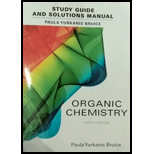
(a)
Interpretation:
The product obtained in the reaction of 3-acetylfuran with nitric acid and sulfuric acid has to be given.
Concept Introduction:
The reaction of sulfuric acid and nitric acid results in the generation of nitronium ion which attacks the most nucleophilic position of the reactant. The nucleophilicity of the carbon atoms present in the furan depends upon the nature of substituents attached to it.
(b)
Interpretation: The product formed in the reaction of 2-nitrothiophene with bromine has to be given.
Concept Introduction:
The reaction of bromine with alkyl and aryl groups is a type of electrophilic substitution reaction in which
(c)
Interpretation: The product obtained in the reaction of 4-dimethylaminepyridine with methyl iodide has to be given.
Concept Introduction:
Tertiary
(d)
Interpretation: The product obtained in the reaction of pyridione with
Concept Introduction:
Phosphorus trichloride reacts with hydroxyl group and leads to the formation of
(e)
Interpretation: The product obtained in the reaction of 1,4-dimethylpyridine hydroxide with formic acid and hydrochloric acid has to be given.
Concept Introduction:
Tertiary amines exist as quaternary ammonium salts in the electrolytic solution. Quaternary ammonium salts are the salts of nitrogen in which four groups are attached to nitrogen and it exhibits a positive charge which is stabilized by the negative charges present in the solution.
(f)
Interpretation: The product obtained in the reaction of pyrrole with
Concept Introduction:
The alkyl group attached to magnesium bromide acts as a nucleophile because carbon atom is more electronegative as compared to magnesium due to which carbon atom exhibits partial negative charge in the reaction of Grignard reagent.
Want to see the full answer?
Check out a sample textbook solution
Chapter 19 Solutions
Student's Study Guide and Solutions Manual for Organic Chemistry
- 1) Draw the correct chemical structure (using line-angle drawings / "line structures") from their given IUPAC name: a. hept-3-yne b. 5-bromo-1-fluoro-4-methylpent-2-ynearrow_forward15. How many absorptions are expected in the H-NMR spectra of fee songs? Explain your were a) CH,CH,CCH,CH, O CHUCH CHCHarrow_forwardFirefly luciferin exhibits three rings. Identify which of the rings are aromatic. Identify which lone pairs are involved in establishing aromaticity. The lone pairs are labeled A-D below.arrow_forward
- What is the [OH⁻] of a 1.80 M solution of pyridine (C₅H₅N, Kb = 1.70 × 10⁻⁹)?arrow_forwardWhat is the percent ionization in a 0.260 M solution of formic acid (HCOOH) (Ka = 1.78 × 10⁻⁴)?arrow_forwardDetermine the pH of solution of HC3H5O2 By constructing an ICE table writing the equilibrium constant expression, and using this information to determine the pH. The Ka of HC3H5O2 is 1.3 x 10-5arrow_forward
- Determine if the following salt is neutral, acidic or basic. If acidic or basic, write the appropriate equilibrium equation for the acid or base that exists when the salt is dissolved in aqueous solution. If neutral, simply write only NR. Be sure to include the proper phases for all species within the reaction LiNO3arrow_forwardAn unknown weak acid with a concentration of 0.410 M has a pH of 5.600. What is the Ka of the weak acid?arrow_forward(racemic) 19.84 Using your reaction roadmaps as a guide, show how to convert 2-oxepanone and ethanol into 1-cyclopentenecarbaldehyde. You must use 2-oxepanone as the source of all carbon atoms in the target molecule. Show all reagents and all molecules synthesized along the way. & + EtOH H 2-Oxepanone 1-Cyclopentenecarbaldehydearrow_forward
- R₂ R₁ R₁ a R Rg Nu R₂ Rg R₁ R R₁₂ R3 R R Nu enolate forming R₁ R B-Alkylated carbonyl species or amines Cyclic B-Ketoester R₁₁ HOB R R₁B R R₁₂ B-Hydroxy carbonyl R diester R2 R3 R₁ RB OR R₂ 0 aB-Unsaturated carbonyl NaOR Aldol HOR reaction 1) LDA 2) R-X 3) H₂O/H₂O ketone, aldehyde 1) 2°-amine 2) acid chloride 3) H₂O'/H₂O 0 O R₁ R₁ R R₁ R₁₂ Alkylated a-carbon R₁ H.C R₁ H.C Alkylated methyl ketone acetoacetic ester B-Ketoester ester R₁ HO R₂ R B-Dicarbonyl HO Alkylated carboxylic acid malonic ester Write the reagents required to bring about each reaction next to the arrows shown. Next, record any regiochemistry or stereochemistry considerations relevant to the reaction. You should also record any key aspects of the mechanism, such as forma- tion of an important intermediate, as a helpful reminder. You may want to keep track of all reactions that make carbon-carbon bonds, because these help you build large molecules from smaller fragments. This especially applies to the reactions in…arrow_forwardProvide the reasonable steps to achieve the following synthesis.arrow_forwardIdentify which compound is more acidic. Justify your choice.arrow_forward
 ChemistryChemistryISBN:9781305957404Author:Steven S. Zumdahl, Susan A. Zumdahl, Donald J. DeCostePublisher:Cengage Learning
ChemistryChemistryISBN:9781305957404Author:Steven S. Zumdahl, Susan A. Zumdahl, Donald J. DeCostePublisher:Cengage Learning ChemistryChemistryISBN:9781259911156Author:Raymond Chang Dr., Jason Overby ProfessorPublisher:McGraw-Hill Education
ChemistryChemistryISBN:9781259911156Author:Raymond Chang Dr., Jason Overby ProfessorPublisher:McGraw-Hill Education Principles of Instrumental AnalysisChemistryISBN:9781305577213Author:Douglas A. Skoog, F. James Holler, Stanley R. CrouchPublisher:Cengage Learning
Principles of Instrumental AnalysisChemistryISBN:9781305577213Author:Douglas A. Skoog, F. James Holler, Stanley R. CrouchPublisher:Cengage Learning Organic ChemistryChemistryISBN:9780078021558Author:Janice Gorzynski Smith Dr.Publisher:McGraw-Hill Education
Organic ChemistryChemistryISBN:9780078021558Author:Janice Gorzynski Smith Dr.Publisher:McGraw-Hill Education Chemistry: Principles and ReactionsChemistryISBN:9781305079373Author:William L. Masterton, Cecile N. HurleyPublisher:Cengage Learning
Chemistry: Principles and ReactionsChemistryISBN:9781305079373Author:William L. Masterton, Cecile N. HurleyPublisher:Cengage Learning Elementary Principles of Chemical Processes, Bind...ChemistryISBN:9781118431221Author:Richard M. Felder, Ronald W. Rousseau, Lisa G. BullardPublisher:WILEY
Elementary Principles of Chemical Processes, Bind...ChemistryISBN:9781118431221Author:Richard M. Felder, Ronald W. Rousseau, Lisa G. BullardPublisher:WILEY





